After teaching for 14 years, I have had my share of students who have ADD, anxiety, hyperactivity, sensory and/or social needs. I strongly believe that teaching the whole child (meeting each child’s emotional, social, academic, physical needs) makes a truly exceptional educator. However, this is not an easy job to do when you have 28 students, each with a different need, in your class!
More days than not, I wear many hats: nurse, mommy, daddy, physiologist, social worker, gym teacher, music teacher, Like it or not, we are no longer just a “classroom teacher.” Can you relate!?!?!
Today I want to share with you a special little corner in my classroom- the calm down corner. The calm down corner is visited by some students more than others and on some days more than others. Depending on the day, my calm down corner is a hopping’ place!
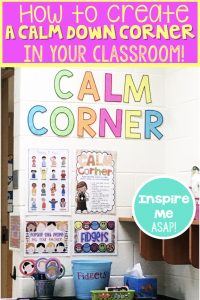
Today was one of those days. MAP testing. Bullying/name calling/hurt feelings at recess. Library book forgotten at home. Student forgot to take his/her ADHD medication. Science project left at home. My sister took my lunch. All these reasons resulted in several students asking to visit the calm down corner, at various points of the day. Truth be told, some days I want to visit the calm down corner!
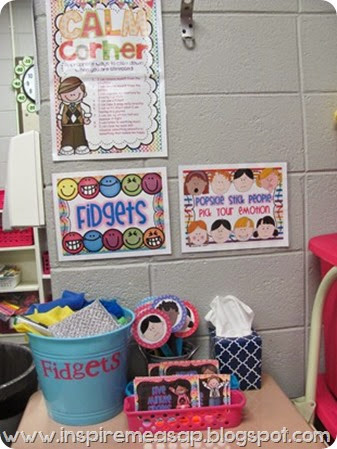
There are many different parts of the calm down corner, but today we had lots of visitors with the fidget bin.
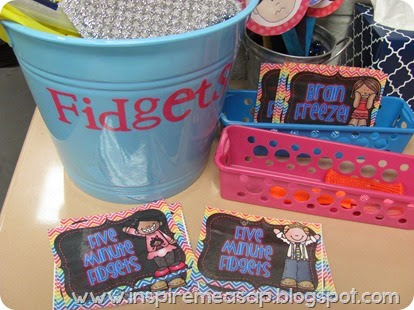
If a child feels the need to “get their energy out,” or “calm down” because they are stressed out, then they can ask me for permission to visit the calm down corner. If it is not during an instructional part of the lesson/activity, then the student takes a five minute fidget pass and goes to visit the calm down corner. If it is during an important part of the lesson, I may just give the student and a fidget that they can hold quietly in their hands.
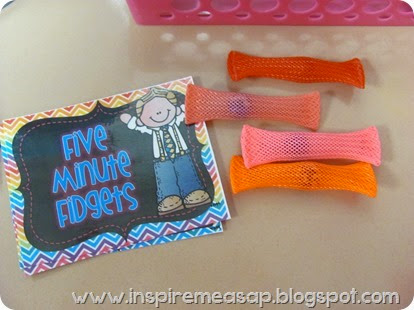
On the other hand, for those students who excess “energy,” then they like the resistance bands. Just like at the gym, I have several different bands that give more and less resistance. One of my students, who was VERY worked up and agitated (not in a good way!) actually snapped one of the bands one day! I couldn’t believe it! That was my cue to get different resistances. I reassured that student that he did not do anything wrong, but he really was taking out his aggression on that resistance band! (And, it worked, I may add!)
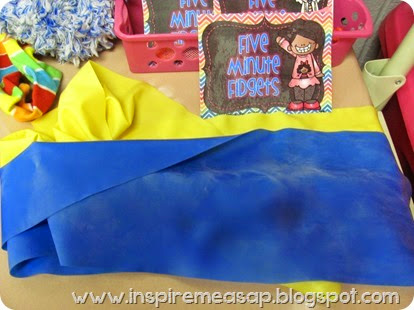
Then, there are times when a student will grab the “fuzzy fidgets.” Today, for example, I had a student request to carry one of the fidgets with her when she was taking her test. It was a small, fuzzy little fidget and she was very worried and had anxiety about her performance on the test. When I let her borrow it, I saw her stroking and petting the fidget as she took her test, with a content look, not a frazzled look, on her face. The fidget did its job again!
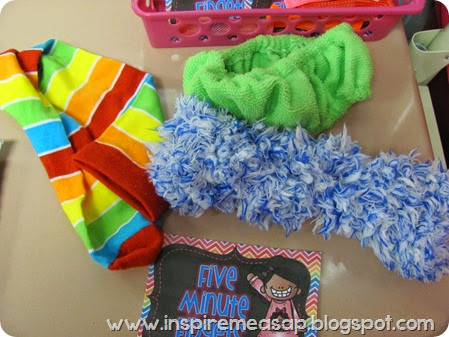
Then, there are some students who will gravitate towards the sensory objects in the bin. They are rough, have bristles, or super soft and rubbery. These students love to experience the texture of the materials in their hands and it helps them to relax and/or focus on their work.
The next group of fidgets probably look familiar to any adult, whether you are a teacher or not, because they are your typical “stress reliever” or “koosh” balls. Students love to squeeze them if they are mad or frustrated about something. Or, just fiddle around with them as they are finishing up their work.

Now for my job- documentation. I, like you, do not have time to document every time a student visits the calm down corner, especially if it is only once in a while that they ask to go there. Some of my students never feel the need to go there all year long! However, every year I have one or two students (possibly more) that I am going through the RTI process with. Or, I need to show documentation to their parents that they are benefiting from some an extra intervention in the classroom. If I have a student who is visiting the calm down corner and using the fidgets more than twice a week, then I am documenting the frequency and the reasons of their visits, along with the success.
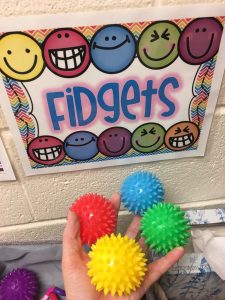
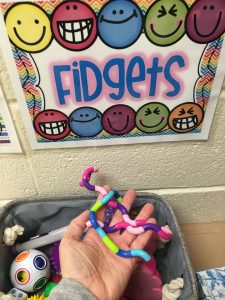
For confidentiality purposes, I obviously did not include a real example from one of my students. However, in the picture above, it shows how I documented the frequency and the reason/observation that the student asked to visit the calm down corner. Most likely, you will start to see a pattern. For example, this student’s visits to the calm down corner would indicate that she/he has test anxiety, since the she/he asked to use a fidget during testing situations. When I discover what the pattern is, then I can address that with the parents and together we can come up with a plan that best helps their child be happy and successful in school.
All of these items are were found from the Dollar Store, Target, or The Chalkboard (our neighborhood teacher store.) Many of the items were a couple of dollars or less and have lasted over the course of several years. I think you will find supporting your kiddos social and emotional health will be well worth the investment!!
Are you looking to create a fidget bin in your classroom? This idea, with many others, can be found in my file about classroom management. Please see the information below if you are interested in purchasing this file
Classroom Management for your (Anxious, Angry, Joyful, Hyperactive) Kiddos

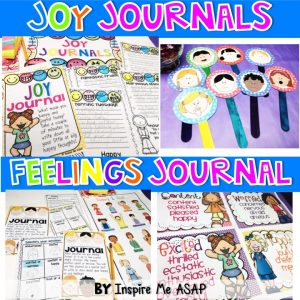
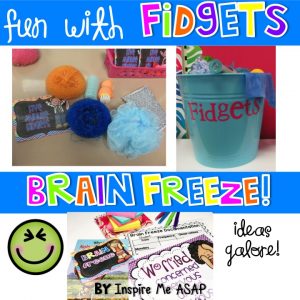

File Description:
This file was created to give ideas for how to help the students who:
-Are happy, joyous, and are loving life! These students will love the joy journal writing about what they are grateful for.
-Are anxious, shy, and overwhelmed. Students who are afraid to speak up in class, get scared during a thunderstorm or fire drill or MAP testing, need a brain freeze pass or a bathroom break.
-Are angry, mad, physically violent towards others or themselves. Some students hide their anger well and some students need help controlling their anger. The shades of anger resources will help these students identify the emotion and appropriate ways to deal with the anger.
-Are embarrassed or sad because they acted on their anger and created hurt somebody else’s feelings. These students need to learn how to how to make a sincere apology.
-Are hyperactive and need help with controlling their excess energy. The five minute fidget pass is a great tool for these students.
-Are working to identify the different emotions that they feel on a daily basis. These feelings are not to be labeled as “bad.” Students need to understand that throughout the day, their emotions change.
However, with specific tools in place, they are better able to manage those emotions.
You will find that your entire class will benefit from some of the ideas presented in this file, such as the joy journal, the feelings journal, the classroom economy behavior system, or “listening with your whole self.” However, you may want to introduce some of the ideas presented in this file with only the students who you feel will benefit the most from them. For example, I only use my brain freeze passes for students who have ADD and I only use the fidgets for those students who have ADHD. However, you know your students best!
This file also includes:
* Resources and ideas for how to implement an individualized behavior plan
*Resources and ideas for how to implement a classroom economy behavior management plan- Students earn credits for good choices and debits for poor choices, getting paid on pay day and either saving their money or shopping for a fun reward
Click HERE to purchase this resource from Teachers Pay Teachers.
Save 10% by purchasing this resource directly from my website.
Do you have a fidget bin or bucket in your classroom? I would love to hear about it!





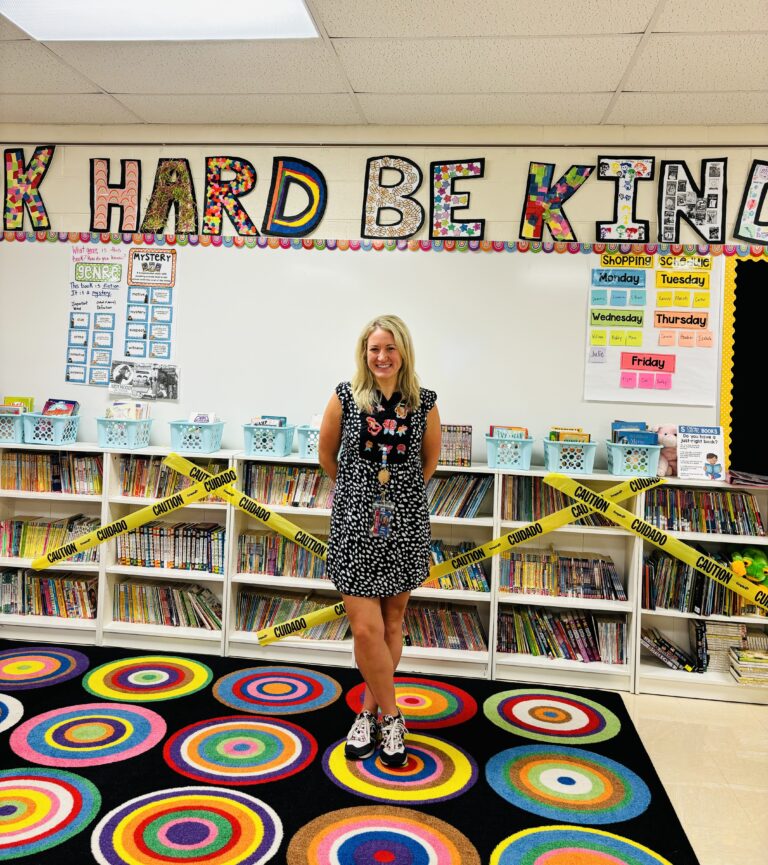



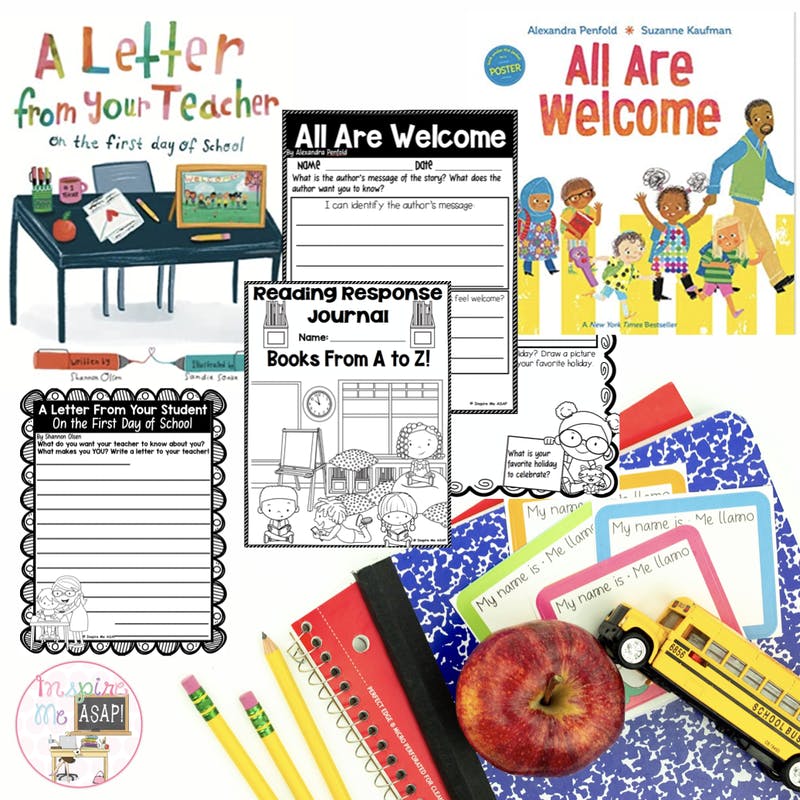
4 Responses
I love this! I have a few students who use fidgets (I teach Special Ed 1st grade), but I didn't think about adding them to our "Chill Out Zone." I also like your variety – thanks for the ideas! Jen
This is great! Just the inspiration I was looking for! Thank you for sharing.
I love this idea and can think of plenty classes to use it in.
Hi, I am interested in knowing how you introduce this to your students at the start of the new year. I want to try a calm corner in my kindergarten classroom for the first time. I have always decided ” when ‘ they get to use fidgets, take a break.
This seems different, can you explain ?
Thanks!